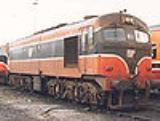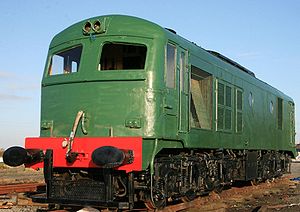
CIE 001 Class
Encyclopedia
The Córas Iompair Éireann
001 Class locomotive was manufactured by Metropolitan-Vickers
at their Dukinfield Works in Manchester
.
The 001 Class locomotive was the backbone of mainline passenger and freight train services on the Irish railway network for forty years from 1955 until the mid-1990s when they were replaced by the new 201 Class
.
Initially they were fitted with eight cylinder two-stroke, port controlled Crossley
engines. These were a loop scavenge type, which utilised a patented principle that recycled the normally wasted exhaust-pressure pulse
to boost charge air in the cylinder. They produced 896 kW (1200 hp) at 625 rpm and could do 120 km/h (75 mph). The original sandboxes, which were utilised to improve traction with the rail, were removed after a few years.
Their Crossley engines proved to be notoriously unreliable from the start. Amongst a plethora of problems were:
These problems were tackled between 1968 and 1971 through the progressive re-engining of the entire class with a 1650 hp 12-cylinder EMD 645
E engine (a similar process was implemented for the original 201 Class
) However, this power output stressed the ability of the original cooling & transmission systems and the engine output was reduced to 1325 hp for improved reliability. When built, these locomotives were originally numbered A1 to A60, and as locomotives were re-engined, they had the suffix 'r' added to their number. From 1972, the prefix letters were dropped and the locomotives were renumbered 001 to 060.
 The first locomotive to be withdrawn was 008, following bomb damage in 1973. The last withdrawal was in 1995; four locomotives of this class have since been preserved as follows:
The first locomotive to be withdrawn was 008, following bomb damage in 1973. The last withdrawal was in 1995; four locomotives of this class have since been preserved as follows:
Córas Iompair Éireann
Córas Iompair Éireann , or CIÉ, is a statutory corporation of the Irish state, answerable to the Irish Government and responsible for most public transport in the Republic of Ireland and, jointly with its Northern Ireland counterpart, the Northern Ireland Transport Holding Company, between the...
001 Class locomotive was manufactured by Metropolitan-Vickers
Metropolitan-Vickers
Metropolitan-Vickers, Metrovick, or Metrovicks, was a British heavy electrical engineering company of the early-to-mid 20th century formerly known as British Westinghouse. Highly diversified, they were particularly well known for their industrial electrical equipment such as generators, steam...
at their Dukinfield Works in Manchester
Manchester
Manchester is a city and metropolitan borough in Greater Manchester, England. According to the Office for National Statistics, the 2010 mid-year population estimate for Manchester was 498,800. Manchester lies within one of the UK's largest metropolitan areas, the metropolitan county of Greater...
.
The 001 Class locomotive was the backbone of mainline passenger and freight train services on the Irish railway network for forty years from 1955 until the mid-1990s when they were replaced by the new 201 Class
IE 201 Class
The Iarnród Éireann 201 Class locomotives are the newest and most powerful diesel locomotives operating in Ireland, and were built between 1994 and 1995 by General Motors. They are model type JT42HCW, fitted with an EMD 12-710G3B engine of 3200 hp, weigh 112 tonnes and have a maximum speed of...
.
Initially they were fitted with eight cylinder two-stroke, port controlled Crossley
Crossley
Crossley, based in Manchester, United Kingdom, was a pioneering company in the production of internal combustion engines. Since 1988 it has been part of the Rolls-Royce Power Engineering group.More than 100,000 Crossley oil and gas engines have been built....
engines. These were a loop scavenge type, which utilised a patented principle that recycled the normally wasted exhaust-pressure pulse
Exhaust pulse pressure charging
Exhaust pulse pressure charging is a system for supercharging two-stroke diesel engines of the loop-scavenge type. Loop-scavenge engines cannot be pressure-charged in the same way as uniflow engines or four-stroke engines because the inlet and exhaust ports are open at the same time.-Overview:The...
to boost charge air in the cylinder. They produced 896 kW (1200 hp) at 625 rpm and could do 120 km/h (75 mph). The original sandboxes, which were utilised to improve traction with the rail, were removed after a few years.
Their Crossley engines proved to be notoriously unreliable from the start. Amongst a plethora of problems were:
- Unbalanced engines resulting in vibration induced fuel and water pipe fractures
- Cylinder defects
- Generator and motor flash-overs
- Excessive water temperature causing shutdowns
These problems were tackled between 1968 and 1971 through the progressive re-engining of the entire class with a 1650 hp 12-cylinder EMD 645
EMD 645
The EMD 645 family of diesel engines was designed and manufactured by the Electro-Motive Division of General Motors. Intended primarily for locomotive, marine and stationary engine use, one 16-cylinder version powered the 33-19 "Titan" prototype haul truck designed by GM's Terex...
E engine (a similar process was implemented for the original 201 Class
CIE 201 Class
The Córas Iompair Éireann 201 Class was a class of 34 diesel electric locomotives manufactured by Metropolitan-Vickers at their Dukinfield Works in Manchester. They were a smaller, lighter and less powerful version of the 001 Class and were originally intended for branch line passenger and freight...
) However, this power output stressed the ability of the original cooling & transmission systems and the engine output was reduced to 1325 hp for improved reliability. When built, these locomotives were originally numbered A1 to A60, and as locomotives were re-engined, they had the suffix 'r' added to their number. From 1972, the prefix letters were dropped and the locomotives were renumbered 001 to 060.
Preservation

- 003: Irish Traction GroupIrish Traction GroupThe Irish Traction Group is a railway preservation society dedicated to preserving diesel locomotives from Irish Railways. It was formed in 1989, with the intention of attempting to preserve at least one example of every type of diesel locomotive to have operated on Irish Rail.They currently own 13...
, West Clare Railway#Preservation - 015: West Clare Railway, Moyasta Junction.
- 039: Irish Traction GroupIrish Traction GroupThe Irish Traction Group is a railway preservation society dedicated to preserving diesel locomotives from Irish Railways. It was formed in 1989, with the intention of attempting to preserve at least one example of every type of diesel locomotive to have operated on Irish Rail.They currently own 13...
On loan to the Downpatrick & Co Down Railway where it is in full working order. It currently carries 1960s black livery. (www.downrail.co.uk) - 055: Hell's Kitchen public house, CastlereaCastlereaCastlerea is located in the west of County Roscommon, Ireland. It is the second largest town in the county with a population of 3,055 . Roughly translated from Irish, Castlerea can mean Brindled Castle or King's Castle...
, County RoscommonCounty RoscommonCounty Roscommon is a county in Ireland. It is located in the West Region and is also part of the province of Connacht. It is named after the town of Roscommon. Roscommon County Council is the local authority for the county...

